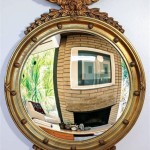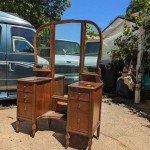How Do You Frame a Bathroom Mirror?
Framing a bathroom mirror elevates the room's aesthetic, adding a touch of elegance and sophistication. A framed mirror becomes a focal point, enhancing the overall design. This seemingly simple project can significantly impact the bathroom's visual appeal, transforming a utilitarian space into a stylish retreat. Whether undertaking a bathroom remodel or simply seeking a quick refresh, framing a mirror is a worthwhile endeavor.
Choosing the Right Frame
Selecting the appropriate frame is crucial for achieving the desired look. Factors such as the existing bathroom décor, mirror size, and personal preferences influence the frame choice. For a modern bathroom, a sleek metal or minimalist wood frame might be suitable. In a more traditional setting, an ornate, carved wood frame or a beveled mirror frame might be a better fit. Considering the mirror's size is essential; a large mirror may require a wider, more substantial frame, while a smaller mirror might benefit from a thinner, more delicate frame.
Material selection is another important consideration. Bathroom environments are often exposed to humidity and temperature fluctuations. Therefore, opting for moisture-resistant materials is vital. Solid wood frames should be properly sealed to prevent warping or damage. Other suitable materials include composite wood, metal, and plastic. These materials offer durability and resilience against moisture, ensuring the frame's longevity.
The frame's color and finish should complement the existing bathroom color palette and fixtures. Matching the frame to the vanity, light fixtures, or other hardware creates a cohesive and harmonious look. Alternatively, contrasting colors can add a bold statement and visual interest. A careful selection of frame color and finish ensures a well-integrated and aesthetically pleasing result.
Preparing the Mirror and Wall
Before commencing the framing process, adequate preparation is essential. The mirror surface should be thoroughly cleaned with a glass cleaner to remove any dust, fingerprints, or residue. This ensures a clean and clear surface for adhesive application. The wall surrounding the mirror should also be cleaned and free of any debris.
Accurate measurements are critical for a successful framing project. Measure the mirror's dimensions precisely, noting the height and width. These measurements will determine the size of the frame needed. It's recommended to double-check measurements to avoid inaccuracies. Slight variations in mirror size can significantly affect the frame's fit.
If the existing mirror is glued to the wall, carefully remove it using appropriate tools and techniques. This may involve using a putty knife or wire to separate the mirror from the adhesive. Exercise caution during this process to prevent damage to the mirror or the surrounding wall. If the mirror is attached with clips, unscrew and remove the clips before proceeding.
Installing the Frame
Various methods exist for attaching the frame to the mirror. One common method involves using mirror adhesive, specifically designed for bonding frames to mirrors. Apply the adhesive evenly to the back of the frame, following the manufacturer's instructions. Carefully position the frame onto the mirror, ensuring proper alignment. Apply firm and even pressure to secure the bond. Allow the adhesive to dry completely before proceeding.
Another installation method utilizes J-channels or clips. J-channels are thin strips of metal or plastic that fit around the mirror's edges, creating a channel for the frame to slide into. This method provides a secure and stable hold. Alternatively, clips can be attached to the back of the frame and then secured to the wall. This method is particularly useful for heavier frames.
After securing the frame, seal the edges with a silicone sealant to prevent moisture from seeping behind the frame. This crucial step protects the mirror and the surrounding wall from water damage. Apply a thin bead of sealant along the perimeter where the frame meets the mirror and the wall. Smooth the sealant with a damp finger or a sealant tool for a clean and professional finish.
For added stability, especially with larger or heavier frames, consider using small L-brackets to secure the frame to the wall. These brackets can be discreetly attached to the back of the frame and then screwed into the wall. This provides extra support and prevents the frame from shifting or becoming loose over time.
Finally, clean any excess adhesive or sealant residue from the mirror and frame. This ensures a polished and finished look. Use a clean cloth and appropriate cleaning solution to remove any remaining debris. Once completed, the newly framed mirror will enhance the bathroom's visual appeal and create a more refined and stylish space.

How To Install A Mirrorchic Bathroom Mirror Frame Momhomeguide Com

How To Frame Out That Builder Basic Bathroom Mirror For 20 Or Less

Diy Framed Bathroom Mirrors Living With Lady

Mirror Frame Diy How To Update A Basic Bathroom Our Faux Farmhouse

Diy Bathroom Mirror Frame Without Removing Clips Her Happy Home

Diy Bathroom Mirror Frame With Molding The Happier Homemaker

Diy Bathroom Mirror Frame For Under 10 O Hayley Blog

Bathroom Mirror Frames 2 Easy To Install Sources A Diy Tutorial Retro Renovation

How To Frame A Bathroom Mirror Easy Casa Watkins Living

How To Make A Diy Bathroom Mirror Frame Thediyplan








